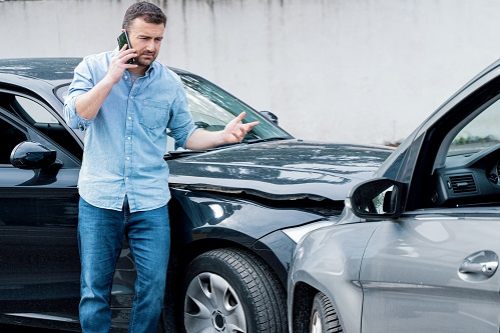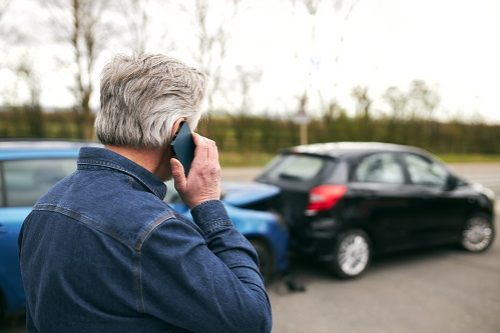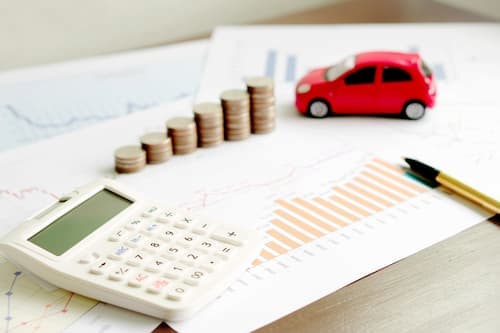What is distracted driving?
Distracted driving is anything that distracts you from the road. Using your phone, eating, and using a navigation system are all forms of distracted driving.
Perhaps the most common form of distracted driving is texting while behind the wheel. Texting while driving is illegal in most states, with Montana being the only state with no law. In many states, handheld cellphone usage is a primary offense, meaning a police officer can pull you over without another reason to do so.
“Distracted driving continues to be a major problem on U.S. roads. While most people probably equate distracted driving with phone use, distracted driving can take on a number of forms,” says Joseph Young, director of media relations for the Insurance Institute for Highway Safety, a nonprofit educational organization. “Everything from eating and drinking to grooming and fiddling with the radio can be distracting and increase crash risk.”
Although distracted driving can lead to traffic tickets and increased insurance costs, drivers who aren’t paying attention can also cause accidents and injuries. For this reason, many states consider distracted driving a serious offense.
Does a distracted driving ticket affect insurance?
Distracted driving can result in higher car insurance rates. However, the impact of a distracted driving ticket on your insurance rates varies by state.
The table below compares average car insurance rates before and after receiving a distracted driving ticket in each state.
| State | Annual premium for clean record | Premium after distracted driving ticket |
|---|---|---|
| Alaska | $1,676 | $2,110 |
| Alabama | $1,860 | $2,422 |
| Arkansas | $1,957 | $2,607 |
| Arizona | $1,812 | $2,764 |
| California | $2,416 | $3,657 |
| Colorado | $2,337 | $2,874 |
| Connecticut | $1,725 | $2,319 |
| Washington, D.C. | $2,157 | $2,509 |
| Delaware | $2,063 | $2,713 |
| Florida | $2,694 | $3,411 |
| Georgia | $1,970 | $2,785 |
| Hawaii | $1,517 | $1,802 |
| Iowa | $1,630 | $2,128 |
| Idaho | $1,428 | $1,744 |
| Illinois | $1,532 | $2,064 |
| Indiana | $1,515 | $2,034 |
| Kansas | $1,900 | $2,315 |
| Kentucky | $2,228 | $3,002 |
| Louisiana | $2,883 | $3,681 |
| Massachusetts | $1,726 | $2,208 |
| Maryland | $1,746 | $2,229 |
| Maine | $1,175 | $1,641 |
| Michigan | $2,352 | $3,227 |
| Minnesota | $1,911 | $2,473 |
| Missouri | $1,982 | $2,463 |
| Mississippi | $2,008 | $2,883 |
| Montana | $2,193 | $2,676 |
| North Carolina | $1,741 | $2,420 |
| North Dakota | $1,665 | $2,055 |
| Nebraska | $1,902 | $2,613 |
| New Hampshire | $1,265 | $1,716 |
| New Jersey | $1,902 | $2,790 |
| New Mexico | $2,049 | $2,540 |
| Nevada | $2,060 | $2,746 |
| New York | $1,870 | $2,078 |
| Ohio | $1,417 | $2,226 |
| Oklahoma | $2,138 | $2,682 |
| Oregon | $1,678 | $2,154 |
| Pennsylvania | $1,872 | $2,262 |
| Rhode Island | $2,061 | $2,798 |
| South Carolina | $2,009 | $2,560 |
| South Dakota | $2,280 | $2,999 |
| Tennessee | $1,677 | $2,122 |
| Texas | $2,043 | $2,874 |
| Utah | $1,825 | $2,329 |
| Virginia | $1,469 | $1,949 |
| Vermont | $1,319 | $1,790 |
| Washington | $1,608 | $2,037 |
| Wisconsin | $1,664 | $2,113 |
| West Virginia | $2,005 | $2,548 |
| Wyoming | $1,758 | $2,065 |
How long does distracted driving affect insurance?
Distracted driving results in a moving violation and can affect your car insurance rates. Most moving violations affect insurance rates for three to five years. However, this can vary significantly from state to state.
Additionally, if your distracted driving leads to an accident, it can affect your insurance rates for an extended period.
What are the three main categories of distracted driving?
Distracted driving usually consists of one of three categories:
- Manual: Using your hands to do something, such as texting, changing the radio, or eating.
- Visual: Taking your eyes away from the road, such as reading a text, looking at your navigation, or turning to talk to someone.
- Cognitive: Anything distracting, such as phone conversations or daydreaming..
“Distractions can be visual, manual, auditory, cognitive, or a combination of these,” Young says. “For example, texting is incredibly dangerous because it combines various types of distraction all at once. Not only are you holding a phone and typing, but you're also looking down away from the road and thinking about what you're typing and how to do it.”
“Research has found that texting can increase crash risk by 2 to 6 times compared with when drivers aren't distracted. More broadly, anything that takes your eyes off the road increases crash risk, and that risk goes up the longer you're looking away,” he says.
How to prevent distracted driving
It’s easy to prevent distracted driving with a bit of forethought. Ways to stop distracted driving include:
- Put your phone in do-not-disturb mode while driving
- Use an app that automatically silences text and call notifications when driving
- Use hands-free technology when possible so that you don’t have to take your hands off the wheel
- Pull over to make calls and read or send texts
- Model good driving behaviors for children and other passengers in your vehicle.
New technology can also help prevent distracted driving.
“Current and emerging technologies may help address some distracted driving. For example, driver monitoring systems (DMS) can track a driver's gaze and head location and issue warnings if a driver is distracted. These systems are already present in some new vehicles and are becoming more common,” says Young.
Safety features on newer vehicles can even prevent a crash.
“Other vehicle innovations, like crash avoidance technologies, can help address the effects of distracted driving. For example, automatic emergency braking, which is now a standard feature on new vehicles, cuts the rate of rear-end crashes by about 50 percent. This technology can kick in if a driver fails to react to a stopped vehicle, and many systems also recognize and stop for pedestrians,” Young says.
Distracted driving examples
When discussing distracted driving, most people think about texting or talking on the phone. However, there are many other ways that drivers can be distracted while behind the wheel.
Here are some examples of distracted driving you may not be aware of:
- Your child is demanding a snack, so you reach into your bag, dig around to find one, open the package, and hand it to them in the back seat.
- You’re late for work, so you apply makeup in the car while driving.
- You go through the drive-through and start eating before you get home.
- Your dog is roaming free in the car and even climbs onto your lap while you are driving.
Distracted driving statistics
Distracted driving comes in many forms and can lead to fines, higher insurance premiums, and accidents.
According to the National Highway Traffic Safety Administration (NHTSA), 3,275 people were killed in 2023 from distracted driving.
“Despite the apparent prevalence of distracted driving (I think we've all seen people staring at their phones while cruising down the road!), it can be challenging to figure out how big of a problem it is. This is partly because distraction takes on many forms, but also because distraction isn't always evident after a crash, so the issue tends to be undercounted,” says Young.
It’s not always possible to know if a driver was distracted, especially cognitively, while driving.
According to Young, “...studies have suggested that distraction likely plays a role in more than a quarter of all crash fatalities, putting it on par with other major traffic safety issues like impaired driving and speeding.”
FAQ: Distracted driving
Which age group has the highest number of accidents attributed to distracted driving?
Drivers who are 15-20 years old have the highest number of fatal distracted driving accidents, according to NHTSA. Additionally, the National Safety Council reports that drivers aged 16-24 have the highest reported use of handheld cellphones, a significant factor in distracted driving.
How much is a distracted driving ticket?
Distracted driving ticket costs vary significantly from state to state. For example, a first offense in Nevada can be as low as $50, while a first offense in New Jersey can be as high as $400.
What are the risks of distracted driving?
Distracted driving leads to traffic tickets, increased insurance premiums, and a higher risk of accidents. You may also face legal fees, fines, and other monetary costs.
Sources:
NSTSA. “Distracted Driving Dangers and Statistics | NHTSA.” Accessed August 2025



